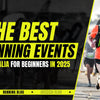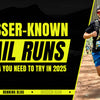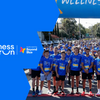What Is a LSD/SLR Run? | Everything Runners Need To Know
This week we’re going to be breaking down something you’ve probably seen seasoned runners throw around a lot on Strava, LSD-s and SLR-s. What's the deal with these leisurely jaunts? Let's break it down.

Alright, so picture this: you're out for a ripper of a run, but instead of pushing the pace, you're taking it easy. That's the vibe of a Long Slow Distance Run or Slow Long Run (LSD/SLR). These runs are all about clocking in the kilometres at a cruisy pace, building up that endurance like a true legend.
Now, why bother with these slow and steady runs, you ask? Well, it's all about laying down the foundation for your running journey. LSD/SLR runs are like the bread and butter of any solid training plan. They help boost your muscular endurance and make you more aerobically efficient, which is just a fancy way of saying they make you a better runner!
When you're pounding the pavement at a leisurely pace, your cardiovascular system gets a sustained workout. Your heart and lungs get better at delivering oxygen and blood to your hard-working muscles, making those long runs feel like a walk in the park.

Plus, running slow helps train your body to tap into the right energy sources, so you can keep chugging along for longer distances without hitting the wall.
Now, you might be wondering just how slow you should go on these LSD/SLR runs. Well, the key is to keep it easy—like, really easy. We're talking about a pace that feels like you could keep it up for hours on end. If you're training by heart rate, aim for mid to upper zone 2, which is around 60 to 70 percent of your max heart rate. It's all about finding that sweet spot where you're working hard enough to get the benefits, but not so hard that you're struggling to keep up.
One thing I like to do is actually bring a tennis ball with me and bounce it as I'm going along.
If you're not used to running slower, this can be a great way of understanding your pace. You should be able to comfortably bounce a tennis ball as you jog along without worrying if you're going to leave it behind. It acts as your pace control.
It's also a good way to keep yourself engaged on a long slow run which could be hours - depending on your training.
(Side Note: LSD-s/SLR-s are also a really great time to practice your race nutrition and figure out what drink mix or gels works best for you to sustain your energy levels.)

And remember, the distance you're covering during a long training run is no joke.
If you're gearing up for a marathon, you're likely working your way up to around 38 kilometres at the peak of your training schedule. So take it easy, enjoy the scenery, and let those muscles soak up the miles. Because when it comes to LSD/SLR runs, it's not about how fast you go—it's about how long you can go.
Long Slow Distance Runs and Slow Long Runs are the secret sauce to building up your endurance and becoming a better runner. Every kilometre you conquer brings you one step closer to reaching your running goals.





